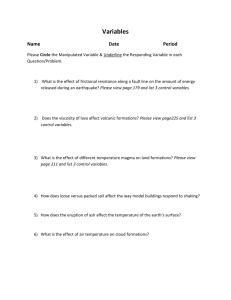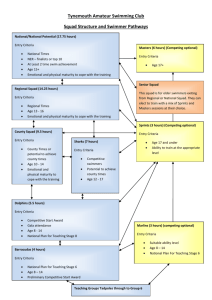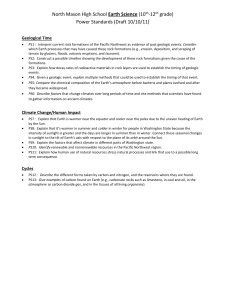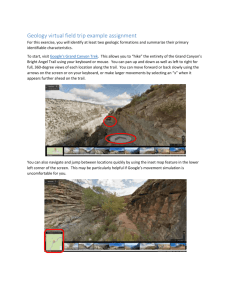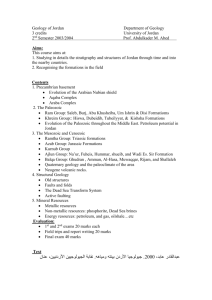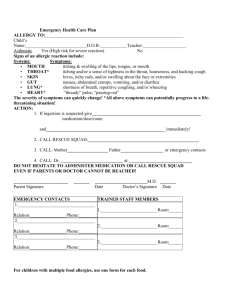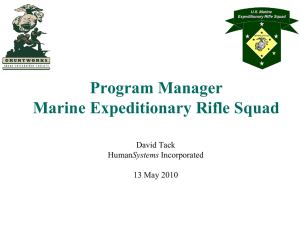UNITED STATES MARINE CORPS
advertisement
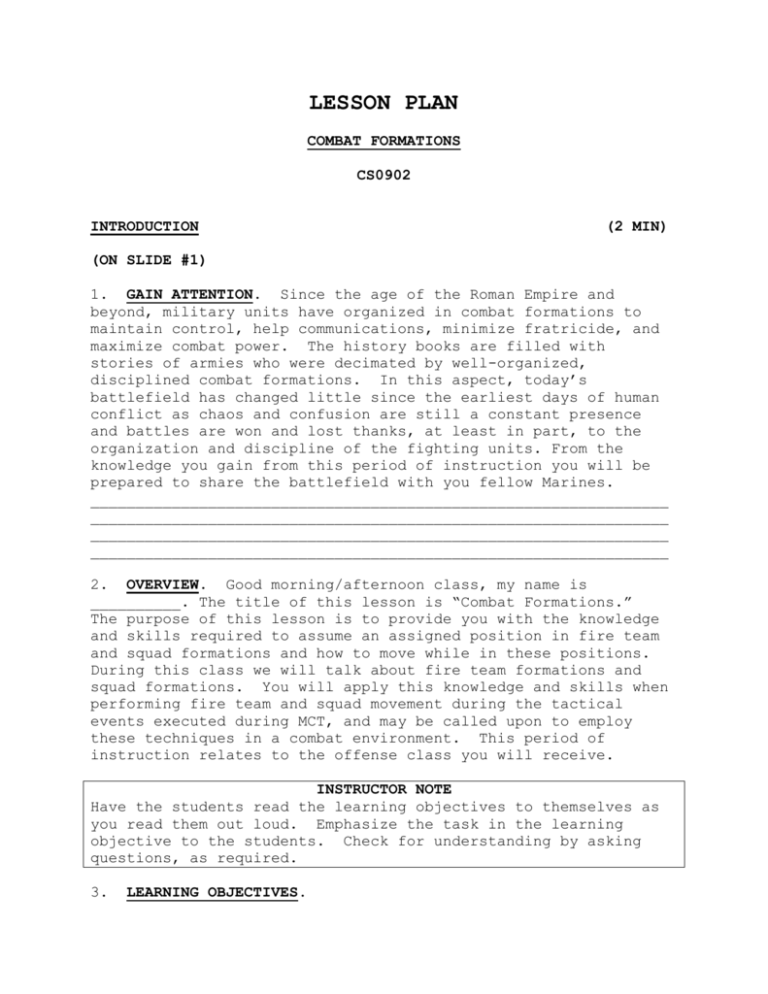
LESSON PLAN COMBAT FORMATIONS CS0902 INTRODUCTION (2 MIN) (ON SLIDE #1) 1. GAIN ATTENTION. Since the age of the Roman Empire and beyond, military units have organized in combat formations to maintain control, help communications, minimize fratricide, and maximize combat power. The history books are filled with stories of armies who were decimated by well-organized, disciplined combat formations. In this aspect, today’s battlefield has changed little since the earliest days of human conflict as chaos and confusion are still a constant presence and battles are won and lost thanks, at least in part, to the organization and discipline of the fighting units. From the knowledge you gain from this period of instruction you will be prepared to share the battlefield with you fellow Marines. ________________________________________________________________ ________________________________________________________________ ________________________________________________________________ ________________________________________________________________ 2. OVERVIEW. Good morning/afternoon class, my name is __________. The title of this lesson is “Combat Formations.” The purpose of this lesson is to provide you with the knowledge and skills required to assume an assigned position in fire team and squad formations and how to move while in these positions. During this class we will talk about fire team formations and squad formations. You will apply this knowledge and skills when performing fire team and squad movement during the tactical events executed during MCT, and may be called upon to employ these techniques in a combat environment. This period of instruction relates to the offense class you will receive. INSTRUCTOR NOTE Have the students read the learning objectives to themselves as you read them out loud. Emphasize the task in the learning objective to the students. Check for understanding by asking questions, as required. 3. LEARNING OBJECTIVES. a. TERMINAL LEARNING OBJECTIVES. (1) Given an individual weapon, as a member of a unit, while wearing a fighting load, perform individual movement techniques, by arriving at the objective. (0300-PAT-1005) (2) Operating as part of a unit, given an individual weapon, while wearing a fighting load, perform actions in a hasty firing position, by assuming a position that allows fire to be placed upon the enemy while taking advantage of cover and concealment. (0300-PAT-1013) 4. METHOD/MEDIA. I will present this lesson using the informal lecture, demonstration, and practical application methods. I will be aided by a multimedia presentation, a demonstrator, and your student handouts. 5. EVALUATION. You will be evaluated on this instruction by a performance evaluation on T-Day ___. To achieve mastery, you are required to correctly perform individual actions and arriving at an objective during a squad live fire and movement range by presenting a minimum target and suppressing the enemy. You must also perform individual actions in a hasty firing position by taking advantage of available cover and concealment. INSTRUCTOR NOTE Explain to the students the procedure for completing the Instructional Rating Forms (IRF). Inform students that you, the primary instructor, will collect the IRF once the entire period of instruction, to include the performance examination. 6. SAFETY/CEASE TRAINING (CT) BRIEF. a. In the event that an injury or mishap occurs that requires immediate medical attention or medical evacuation, training will cease until the situation can be properly managed and required number of personnel is on hand to continue training. Unless otherwise directed, all students should move safely away from the incident and await further instructions from an instructor. b. All Marines are reminded to immediately inform an instructor of any situation that they feel is unsafe or of any injury or accident that may occur during training, no matter how slight. c. Training, once ceased, will not be resumed until the incident has been reported to the chain of command and higher authority has authorized training to continue. (ON SLIDE #2) TRANSITION: Are there any questions concerning anything we have covered so far? (Pause and receive questions) I encourage each of you to take your own notes in your student handout. Let's begin the lesson by discussing the purpose of combat formations. (ON SLIDE #3) BODY. 1. (640 MIN) COMBAT FORMATIONS. (20 Min) Fire team and squad formations are groupings of individuals and units for efficient tactical employment. The factors influencing the leader's decision as to the selection of a particular formation are the mission, terrain, situation, weather, speed, and degree of flexibility. Combat formations and signals enable the leader to control the movement and maneuver of his unit when moving to and assaulting an enemy position. (ON SLIDE #4) a. Basic Combat Formations. (1) Normally each unit leader will determine the formation for his unit. Thus, a unit may contain a variety of formations at any one time and these formations may change frequently. (2) The relative position of the units within the formation should be such that one will not mask the fire of the others. It is not important that exact distances and intervals be maintained between units and individuals as long as control is not lost. (3) Visual contact will be maintained within the fire team and between fire team leaders and squad leaders. (4) All movement to change formations is by the shortest practical route. (ON SLIDE #5) b. Military Symbols. In all fire team formations remember: "Ready, Team, Fire, Assist", for positioning fire team members. Each member of the fire team is identified by his own symbol. (1) Ready identifies the riflemen. The symbol for the riflemen is a blank circle or the letter "R" encased by a circle. (2) Team identifies the team leader. The symbol for the team leader is a circle with a diagonal line through it. (3) Fire identifies the automatic riflemen. The symbol for the automatic riflemen is an arrow encased by a circle. (4) Assist identifies the assistant automatic riflemen. The symbol for the assistant automatic riflemen is the letter "A" encased by a circle. (ON SLIDE #6) c. Squad Leader Symbol. The symbol that identifies the squad leader is the letter “X” encased by a circle. The lower part of the “X” is darkened in. (ON SLIDE #7) TRANSITION: Thus far we have covered the purpose of combat formations and the military symbols. Are there any questions about this information? (Pause and receive questions) If there are no (more) questions for me, I have a few for you. QUESTION: Describe the symbol that identifies the rifleman? ANSWER: The symbol for the riflemen is a blank circle, or the letter "R" encased by a circle. QUESTION: How are movements to change formations accomplished? ANSWER: All movements to change formations are by the shortest practical route. ________________________________________________________________ ________________________________________________________________ ________________________________________________________________ Next, we will discuss fire team formations. (ON SLIDE #8) INSTRUCTOR NOTE Have students draw the formations into their handouts as you discuss each one. 2. FIRE TEAM FORMATIONS. (30 Min) a. Column. (1) Used when speed is essential and enemy contact is not probable or the enemy position is known. (2) Permits rapid, controlled movement. (3) Favors fire and maneuver to the flanks. (4) Vulnerable to fire from the front because it provides the least amount of fire to the front. (5) The formation is organized rifleman then the team leader, automatic rifleman, and assistant automatic rifleman (ready, team, fire, and assist). (6) The ready will start to the left and alternate right then left covering down behind the Marine in front of them and at least ten meters in between each Marine. (7) At night, members of the column are close enough to maintain visual contact with the Marine in front of them. (ON SLIDE #9) b. Wedge. (1) Used when enemy contact is probable, and/or the enemy’s position is unknown. (2) Permits good control of the formation. (3) Provides all-round security. (4) Formation is flexible. That is, Marines are able to move quickly into other formations. (5) Fire is adequate in all directions. (6) Team leader and assistant automatic riflemen can be on either side. (7) The formation is organized ready, team, fire, and assist in a counter clockwise direction. (8) The Marines are at least ten meters apart. (9) At night, the Marines stay close enough to maintain visual contact. (ON SLIDE #10) c. Skirmishers Right (Left). (1) While in the skirmishers right, all members of the fire team are to the right of the riflemen. A skirmisher left is just the opposite. (2) The Marines are staggered ready, team, fire and assist, front to back and aligned to each other. A skirmisher left is organized in the same manner. (ON SLIDE #11) (3) The Marines are at least ten meters apart. (4) At night they will be close enough to maintain visual contact. (5) Used when the location and the strength of the enemy are known. A good time to use skirmishers formation is during the assault, when mopping up, or when crossing short open areas. (6) This formation provides maximum firepower to the front. (ON SLIDE #12) d. Echelon Right (Left). (1) While in the echelon right, all members of the fire team are to the right of the riflemen. Echelon left is just the opposite. (ON SLIDE #13) (2) Used to protect an open or exposed flank by providing security and firepower in the designated direction. (3) Provides heavy firepower to the front and echelon flank. (4) The formation is organized ready, team, fire, and assist. All Marines will be to the right or left of the rifleman at a forty-five degree angle, depending on the formation. (5) The team leader may be on line or slightly back from the formation as needed for better control of his Marines. (6) The Marines will be at least ten meters apart. (7) At night, Marines stay close enough to maintain visual contact with each other. (ON SLIDE #14) TRANSITION: We have now discussed fire team formations. Are there any questions over anything we have covered up to this point? (Pause and receive questions) If there are no (more) questions for me, I have a few for you. QUESTION: What formation permits rapid and controlled movement? ANSWER: Column formation. QUESTION: What formation provides all-round security? ANSWER: Wedge formation. ________________________________________________________________ ________________________________________________________________ ________________________________________________________________ Next, we will discuss squad formations. (ON SLIDE #15) 3. SQUAD FORMATIONS. (20 MIN) a. The squad leader prescribes the formation based on his assessment of the situation. In all the squad leader ensures that he is in a position best control the unit. More often then not, this center of the formation. for his squad formations, where he can is toward the (1) Fire team leaders may make subsequent changes to their fire team formation. (2) The characteristics of squad formations are similar to those of the fire team. (3) The fire team is the maneuver element in squad a formation. (ON SLIDE #16) b. Squad Column. behind the other. Fire teams are arranged in succession one (1) Used when speed is essential and enemy contact is not probable, or the enemy position is known. (2) Easy to control and maneuver. (3) Excellent for speed of movement or when strict control is desired. (4) Especially suitable for narrow covered routes of advance, maneuvering through gaps between areas receiving hostile artillery fire, moving through areas of limited observation, and moving under conditions of reduced visibility. (5) Vulnerable to fire from the front or rear. (6) Often used at night. (7) The formation is organized first, second, third team, and in order, rifleman, team leader, automatic rifleman, and assistant automatic rifleman for all three fire teams. (8) The ready will start to the left and alternate right then left covering down behind the Marine in front of them and at least ten meters in between each Marine. (9) At night, Marines stay close enough to maintain visual contact with the Marine in front of them. (10) The squad leader is positioned in between the first and second fire teams, but he may move throughout the squad in order to maintain control. (ON SLIDE #17) c. Squad Wedge. (1) Used when enemy contact is probable and the enemy position is unknown. (2) Permits good control so Marines can react to the enemy quickly. (3) Provides all-round security, so there is firepower in all directions. (4) Formation is flexible so that Marines can change directions or formations rapidly. (5) Firepower is adequate in all directions. (6) The formation will go by teams, in order, in a counter clockwise direction. The first team will be in front, the second team to the left and the third team directly to the right of the second team. No team will be covered down on each other. All teams will be in a fire team wedge. (7) At night, Marines stay close enough to maintain visual contact with the Marine in front of them. (8) The squad leader will be in the middle of the teams, but he may move throughout the squad to best control his squad. (ON SLIDE #18) d. Squad Line. (1) Used when the location and strength of the enemy are known. An example of using squad line is using it during the assault, when mopping up, or when crossing short open areas. (2) Maximum firepower is to the front. (3) Combat formation will be organized by teams. The first team is in the middle, the second team to the left and the third team directly to the right of the first team. No team is covered down on another. The Marines are positioned at least ten meters apart. (4) At night, Marines stay close enough to maintain visual contact with the Marine in front of them. (5) The squad leader will position is directly behind the middle of the teams, but he may move throughout the squad to maintain control. (6) The formations of the fire teams are determined by what side of the squad they are on and the assessment of the squad leader. (ON SLIDE #19) e. Squad Echelon. (1) Used to protect an open or exposed flank. (2) Provides heavy firepower to front and echelon flank. (3) The squad leader will organize the formations by teams. The first team to the left and in front, the second team in the middle, and the third team at the end. No team is covered down on another. The squad is at a forty-five degree angle to the left or right. The Marines are at least ten meters apart. (4) At night, Marines stay close enough to maintain visual contact with the Marine in front of them. (5) The squad leader position is in the middle of the first and second team, but may move throughout the squad to maintain control. (6) The squad leader determines the formations of the fire teams. (ON SLIDE #20) f. Squad Vee. (1) Used when the enemy is to the front and his strength and location are known. This formation will be used when crossing large open areas. Primarily used as a final formation before coming on line in the assault. (2) Facilitates movement into squad line. (3) Provides excellent firepower to front and flanks. (4) Provides all-round security, so there is firepower in all directions. (5) The squad leader will organize the formations by teams. An example of the organization set up is the first team in the middle, the second team to the left and in front of the first team, the third team directly to the right and in front of the first team. No team is covered down on another. The Marines are at least ten meters apart. (6) At night, Marines stay close enough to maintain visual contact with the Marine in front of them. (7) The squad leader will take his position in the middle of the teams, but he may move throughout the squad to maintain control. (8) The formations of the fire teams are determined by what side of the squad they are on and the assessment of the squad leader. (ON SLIDE #21) INTERIM TRANSITION: So far we have covered fire team formations and squad formations. Are there any questions regarding this information? (Pause and receive questions) Next, we are going to move into the demonstration portion of the lesson. DEMONSTRATION: (15 Min) The purpose of this demonstration is to show the students how to conduct fire team and squad size formations. Student instructor ratio will be 400:6 STUDENTS ROLE: Observe the demonstration. You can take any notes you feel is needed to ensure your understanding of the material. INSTRUCTOR ROLE: Begin by demonstrating all the combat formations. Also utilize the hand and arm signals for each formation. Then demonstrate how to move to a designated objective as a squad-size element. Safety Brief: Given by the Range Safety Officer. Supervision and guidance: Ensure all students grasp the concept of combat formations. Debrief: After the demonstration ask the students if there are any questions. Summarize and clear up areas of confusion. INTERIM TRANSITION: Now that we have seen a demonstration of combat formations are there any questions on anything you have seen? (Pause and receive questions) Next, you will perform the practical application portion of the class. After today, you will perform this practical application again before you live fire. PRACTICAL APPLICATION: (555 Min) The practical application is designed to give the students the opportunity and experience in executing combat formations. Student instructor ratio will be 400:16 This practical application will be broken up throughout the training schedule totaling 9 hours and 15 minutes. PRACTICE: The students will practice moving as a fire team and squad on line to a simulated objective. The students will be given the opportunity to execute movement as they would on the fire and movement range. PROVIDE-HELP: Each Combat Instructor will assist the Marines at his station. Ensure that the instructors are answering questions form the students. 1. Safety Brief: The Range Safety Officer will give every student a safety brief. 2. Supervision and Guidance: Ensure all students grasp the concept of combat formations. Allow students the total time of 555 Min to practice. 3. Debrief: Ensue that all students have executed proper combat formations. After the practical application, ask the students if there is any questions. TRANSITION: Now that you have had the opportunity to perform the practical application, are there any questions about anything we have covered during this lesson (Pause and receive questions) (ON SLIDE #22) SUMMARY (3 MIN) During this class we have discussed fire team formations and squad formations. Armed with this information, you are now able to effectively move as a member of a provisional rifle squad. Those with the instructional rating forms please respond to the questions and make comments as appropriate and I will collect them once you are finished. INSTRUCTOR NOTE Refer to the training schedule and provide the students with instructions regarding what to do and where to form in preparation for beginning the performance examination.
